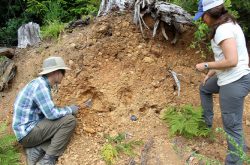
Researchers at the University of Washington, Portland State University and the University of Oregon have shown that deep-seated landslides in the central Oregon Coast Range are triggered mostly by rainfall, not by large offshore earthquakes.
The open-access paper was published Sept. 16 in Science Advances.
“Geomorphologists have long understood the importance of rainfall in triggering landslides, and our study is simply driving home just how important it is,” said first author Sean LaHusen, who did the work as part of his doctorate at the UW. “Our results show that more frequent, localized landslide events triggered by rainfall are just as important to consider as less frequent but more far-reaching Cascadia Subduction Zone earthquakes.”
Heavy rains are known to cause landslides that can be disruptive and deadly. A less frequent trigger for a landslide would be a rupture of the geologic fault off the coast of Washington and Oregon that’s known as the Cascadia Subduction Zone — adding to a long list of concerns after a major earthquake. Landslide risks of all types increase if human development or wildfires remove trees, taking away the roots that stabilize the soil.
Recent research in Nepal and Japan, however, suggests that offshore earthquakes might not trigger as many landslides as previously believed. The new study finds a similar situation in the Pacific Northwest.
Read more at UW News »
